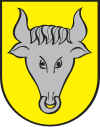
Alternate names: Dynów [Pol], Dinov [Yid]. 49°49' N, 22°14' E, 19 miles SSE of Rzeszów, 78 miles W of L'viv (Lvov). 1880 Jewish population: 1,241. Yizkors: Khurbn Dynow, Sonik, Dibetsk (New York, 1949/50) and Sefer Dynow; sefer zikaron le-kedoshei kehilat Dynow she-nispu ha-shoa ha-natsit (Tel Aviv, 1979). ShtetLink. town photos. Słownik Geograficzny Królestwa Polskiego (1880-1902), II, pp. 255-256: "Dynów". At this town in Rzeszów County, Subcarpathian Voivodeship with a population of 6,058 in 2008, on the first day of Rosh Hashanah 1939, Wehrmacht soldiers mass murdered 200 Jews from the town. Then, 150 Jews were machine gunned after being taken away from the town on trucks. Fifty were burned alive in the prayer house. There are two cemeteries for the town. photos. [April 2009]
The old cemetery has almost no visible gravestones. The new cemetery has an ohel of Rabbi Tzvi Elimelech Shapira. [July 2011]
Simon Geissbuehler: Back in Poland, I tried to visit the ohel in Dynów where - among others - the great Rabbi Tzvi Elimelech Shapira is buried, but the cemetery was closed. The old Jewish cemetery is completely overgrown and almost no gravestones are left. [July 2012]
DYNOW: I US Commission No. POCE000151
This old cemetery is at Jozefa Pitsudskiego Str. 8. 1991 population: 1000-5000 with no Jews.
- Town: Vrzad Gminy at Rynek 2, Tel #113.
- Regional: konservator Pawet Koziot, 37-700 Przemysl, Rynek 24, Tel # 5944.
1921 Jewish population was 1273. Buried in this unlandmarked Orthodox cemetery are Chi Elimelech (1785-1841) and David G. Cwi (1804-1874). The isolated urban flat land is reached by turning directly off a public road and open to all. There is a continuous fence with non-locking gate. The approximate size is 1.30 hectares both before and after WWII. There are no stones visible. There are no mass graves. Municipality owns property used for recreation. Properties adjacent are either urban or agricultural. Occasionally, organized Jewish group tours visit. The cemetery was vandalized during WWII. Local/municipal authorities and/or Jewish groups abroad fixed wall. Within the cemetery is an ohel. No threats.
Jan Pawet Woronczak, Sandomierska Str. 21 m.1 02-567, Warsaw, Tel # 49-54-62 completed this survey on December 31, 1991 and visited site in August 1990. Documentation was found at Monuments Conservation office in Przemysl.
DYNOW: II US Commission No. POCE000152
This (new) cemetery is located S of the town, W 150 m. from the road to Kamrolowka.
The Orthodox community probably established this cemetery in the 19th century. The isolated suburban hillside has no sign, but has a Jewish symbol on a gate. Reached by turning directly off a public road, access is open with permission. A continuous fence with a gate that locks surrounds it. It encompasses 0.5 hectares, the same as before WWII. 1-20 gravestones, none in original locations and 50% to 75% of them toppled or broken, date from end of the 19th century to 20th century. The sandstone finely smoothed and inscribed stones with no decorations or portraits have Hebrew inscriptions. There are no known mass graves. Municipality owns property is for Jewish cemetery. Properties adjacent are agricultural. It was vandalized during WWII. The stones have been re-erected and the gate and wall fixed. There is a moderate threat of vandalism and uncontrolled access.
Jan Pawet Woronczak, Sandomierska Str. 21 m.1 92-567 Warsaw, Tel# 49054-62, completed survey on January 7, 1992. Robert Kaskow and Marcin Wodzinski visited the site in August 1990. Interviews were conducted.
Photos by Charles Burns [February 2016]
